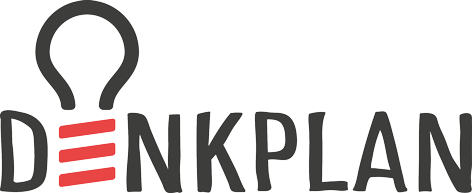Der Erfolg jeder methodischen Idee beruht auf dem dahinter verborgenen mentalen Modell. Leider kümmern sich die wenigsten um das mentale Modell und wundern sich dann, wenn die Anwendung der methodischen Instrumente nicht funktioniert. Häufig ist ein nicht verstandenes mentales Modell die Ursache. Daher dieser Blog zum mentalen Modell hinter Denkplan.
The agile and lean community lives a widely agreed mental model. This mental model starts from the needs of a person or organization and drills down to concrete techniques and tools that support specific actions. The spine model of well-known drivers in the community describes this mental model as following.
“Once you understand the reason [the human work] system exists in the first place, and the reason you want to be a part of the system (Needs), you can decide what to optimize for (Values). Once you have decided what you are optimizing for, you can decide what ecological levers are going to get you there (Principles). Once you have that, then decide how you are going to do it (Practices). And once you have done that, decide if any refinement is needed (Tools).”

Denkplan is based on Agile & Lean values
Denkplan bezieht sich auf die folgenden Werte und Prinzipien des spine Modells als die treibende Kräfte
- Transparenz
- Kommunikation und Feedback Kultur
- Kadenz und Synchonisierung
- Wert (business value) basierte Priorisierung
- Fokus (Fokus, focus, focus, …)
- Eine geschickte und geeignete Kombination aus haptischen und elektronischen Instrumenten
Transparency
Transparency is an often used and abused term. I recommend a test: as normal average employee, go and ask for the full and complete version of the current strategy presentation. I guess in many companies the answer will be: confidential. This is just weird. How can management expect that every employee is motivated to realize an unknown strategy?
Transparency is a core value in Denkplan. Transparency includes every single person working in the organization. Strategy must have a vivid and visual representation. It shall be easy to understand. A visual representation and physical instruments to work with motivate to start conversations fostering feedback and driving strategy evolution. Ideal everybody may participate, but do not expect everybody to participate.
Conversation and feedback culture
Denkplan is not a receipt. It is an approach that requires a healthy base and adoption to succeed. Denkplan is based on agile and lean values and principles. Conversation and a feedback culture are core agile values for the optimal adoption of the Denkplan concepts. Non-agile environments will benefit from these concepts as well, but the full potential most probably will stay undiscovered. By the way, that is my experience for many agile instruments applied in non-agile organization. Without an agile mindset behind you may end up disappointed and say the instrument failed. Like taking a knife by the blade and blaming the knife.
There is a new chance in Denkplan. In many organizations that introduced agility in some way, still the top management and parts of the so called business stick the previous values and way of doing things. This could be a disaster because two different mental models potentially clash. That’s full of risks. Denkplan offers the potential to integrate management and business in the agile mental model in a way they like and want to be part of it. At least this is our experience in many experiments.
Cadence and synchronization
Classical project leads, and manager often say agile and lean systems would be chaotic and change direction and goals from day to day. That is nonsense. Agile working is well structures and disciplined. Scrum for example recommends a very strict meeting culture called events. Every event has a very specific focus, agenda and content. Every event has its strict cadence and length. This is discipline.
Just as a side statement: My personal observation is that agile is hard for many individuals right because it demands a sound level of self-discipline and commitment. And, to be frank: We as human beings do have our problems with self-discipline and commitment from time to time – especially if we are under stress.
Denkplan leads the discipline as in Scrum to the level of the whole organization. Around the instruments and elements of Denkplan (Scrum would say the artifacts) we recommend establishing an event culture with a fixed cadence, with well-defined participants, a focus agenda and clear goals what to achieve. This discipline fosters conversations and feedback while being efficient. In general, such a meeting culture is an efficient replacement of many unstructured ad-hoc meetings with unclear goals, too many attendees and no goals defined – but this is out-of-scope of this blog series. Let’s stay focused…
Value based prioritization on all levels
The problem of many companies leading strategy to action is prioritization. Most companies decide to push just every single idea listed in the strategy as project into the portfolio – at least the ones of the most influencing management members. Background are political reasons to make every strong influencer on or just below C-Level at least a bit happy. These persons are as well the project sponsors deciding about budget. That’s important as the next step following is defining budget posts for every portfolio item for the next twelve months to express at least some kind of importance. The budget game is time consuming and – worse – leads to a peer competition within the organization. Wouldn’t it be better everybody pulling in the direction of an agreed strategy? And the result of this budget battle – large projects win, small projects tend to starve to death, although a small project could result in a tremendous gain.
Denkplan plays another game. There are no “projects” in the classical way. In fact we avoid the term project at all. Instead the evolution of the company uses a portfolio of (ideally) equal sized (we call them) initiatives driven by strategic themes. Smart business goals define the development of a strategic theme (we actually use the canvas technique) and its evolution over time. An initiative is a single evolution step in a theme with a short lead time, creating a well-defined and measured business value. In this way the company collects fast feedback often about successful and failing initiatives. This offers the chance to explore and learn about the market and customers. Prioritization of upcoming initiatives is based on this learning what creates values. This is what we treat a business value based prioritization on a roadmap level. We treat this as the most abstract action level below the strategy. It is on level tactical implementation of he strategy
By the way, Jeff Patton created a wonderful and very powerful instrument to work visual with value based prioritization – the concept of the story map. We applied and adopted Jeff’s idea of story mapping on company level as a key element in Denkplan.
Focus
Die Nummer eins Fragen auf Ebene Unternehmensleitung und Portfolio Management sind: Wann haben wir das Ergebnis des Projekts? Geht es nicht schneller? So ist es: Unternehmen wollen 1. möglichst alles und 2. das möglichst sofort.
Kurzes Intermezzo: Die Nummer zwei Fragen sind: Wo können wir Kosten einsparen? Geht das gleiche nicht billiger? Ich bitte um Entschuldigung, aber – diese Fragen sind die falschen Fragen. Ein Unternehmen hat ein Investitionspotential in Form von Cash Out plus Personalkosten. Das ist gegeben aufgrund der Wirtschaftskraft des Unternehmens (und dem Glauben der Aktionäre). Punkt. Will ein Unternehmen Kosten sparen, also entweder weniger Geld ausgeben oder weniger Personal beschäftigen, dann muss es zuerst etwas dafür tun oder auf etwas verzichten. Intern bedeutet etwas tun (denn wer verzichtet schon): Erst investieren, um zukünftig Geld zu sparen. Digitalisierung in der Form Automatisieren von Geschäftsprozessen ist so ein Invest und zielt in Richtung Effizienz von Geschäftsprozessen. Beim externen Sparen besteht der Irrglaube: Ich mache dem Lieferanten Druck und bekomme die Leistung billiger. Das ist oft ein Trugschluss, da – erst nach einiger Zeit und dann zumeist drastisch sichtbar – die Qualität der Leistung ebenfalls sinkt, ausser der Lieferant hat zuvor investiert, etwa in Digitalisierung. Einfach Kostensparen geht jedenfalls nicht. Wann merken das die Unternehmen nur endlich…
Zurück zur «geht es nicht schneller» Diskussion: Meine Lieblingsantwort ist, wenn ich sonst nichts über das Unternehmen weiss: Stoppe 50% deiner Projekte SOFORT, nehme dazu diejenigen die knorzig laufen und eh nicht so recht vorankommen. Du wirst sehen, die anderen Projekte nehmen plötzlich gewaltig Fahrt auf. Nachher wirst du nicht einmal einen Verlust feststellen – ganz im Gegenteil.
Was steckt dahinter: Queueing Theorie. Queueing Theorie kennt den richtigen Umgang mit verstopften, zu langen und verhängten Queues schon lange. Don Reinertsen schrieb dazu ein fantastisches Buch (the principles of product development flow), das anschaulich schildert, wie mit Projekten in den Verarbeitungsqueues des Unternehmens umgegangen werden sollte – übrigens mit Wert orientierter Priorisierung. Nur leider kennen die wenigsten Portfolio Manager oder das Top Management die Theorie oder das Buch. Die Kernaussagen sind einfach aufgezählt, vom Mindset her jedoch schwer im Unternehmen zu verankern: Kosten durch Verzögerungen minimieren (knorzige Projekte); möglichst geringe Anzahl Elemente (Projekte) in der Queue, die vor einem Worker (Team) warten; Geringe Varianz der Batches (Projektdauer), kleine Batchsize (Projektgrösse). Denkplan integriert diese Queueing Konzepte.
The smart combination of physical and electronic instruments
Agility is a lot around conversation. Conversation is established in events (meetings) that follow a cadence and synchronize the information and feedback flow in the organization. Conversation requires instruments that foster conversation leading to a common agreed vision, to decisions and consensus. On the other hand, there is a lot of additional information “hooked” to the instruments used in the conversations. A good example is Scrum and the card-conversation-confirmation practice, called CCC. The card is the hook. And, for example in Jira (or – worse – PowerPoint presentations), many additional and valuable information is hooked to that card in the tools, like a business case (better: a canvas), a customer journey, acceptance criteria, interface mockups, drawings, whatever.

Conclusion
Good – this blog hasn’t revealed any details about Denkplan. It deals with mindset and some of the problems and classic behaviors in companies. This is where Denkplan’s great leverage lies. This is also the opportunity with Denkplan to make a difference, to clean up some harmful behavioral patterns in companies – regardless of whether we want to call it agile, classic, lean, or simply common sense plus a rich existing wealth of experience.
The following blogs are then dedicated to details of the Denkplan methodology. Nevertheless, as a reminder: When I describe the mechanics of one of the three core instruments from Denkplan, the mindset behind the mechanics is just as important as the instrument itself.



